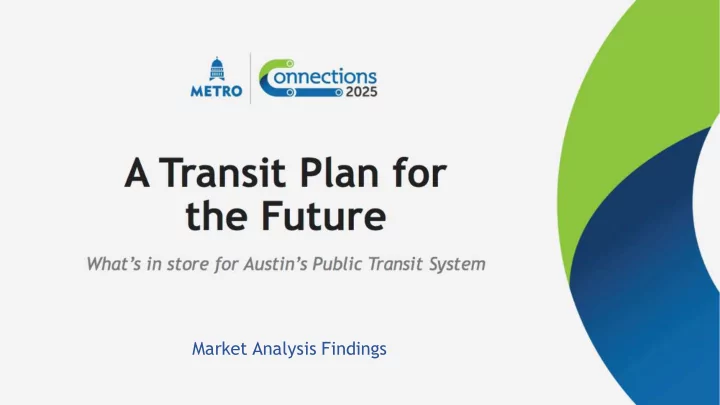

Market Analysis Findings 1
Project Overview and Status We are here Completing market assessment and service evaluation. Establishing framework and approach to develop Transit Plan. 2
Connections2025 Market Analysis, Service Evaluation, and Plan Framework 3
Market Analysis Components § Population, Employment and Demographics – Where are the transit supportive densities located? § Land Use and Development – How can future densities, land use mix, and street patterns influence transit? § Mobility Needs – Where are people going and how are people traveling? 4
Market Analysis Goals Live-Work-Play Lifestyle Combined with the Mobility All-day, all-week spontaneous use network service evaluation, the goal is to define a geographic context for Targets commuter, low-income, and senior Targeted transit markets. mobility needs Mobility 5
Rapid Central Texas Population Growth Between 2015 and 2025, population will: § Increase by 20% in Austin § Increase by 29% in Travis County Between 2015 and 2040, population will: § Increase by 45% in Austin § Increase by 80% in Travis County 6
Employment Trends § Unemployment rate has decreased dramatically in the last five years. § Large employers are located in the northern parts of Austin and adjacent communities. § Tech Ridge, Jollyville, Domain, Windsor Park, and Mueller are projected to see greatest employment growth. 7
8
Central Texas Demographic Trends § Analyzed groups that typically have higher propensity to use transit: • Age groups • Low-income residents and households • Minority residents § Analysis lends to: • Geographic context for each group and their relationship to current transit services • Identifies likely future growth in key market segments 9
Market Segment: College-Aged Residents § Over 80 percent of UT students live within 5 miles of campus. § Need to focus on other vital user groups to generate ridership and strengthen the system. § Serving UT , ACC, and other colleges will remain a key factor. 10
Data detailing the UT students’ locations reveal that: § 50% of total UT students live within 1 mile of campus. § 80% of total UT students live within 5 miles of campus. 11
Market Segment: Young Professionals § Studies show this age group has higher propensity to use transit. § Highest concentrations in the more urban areas with access to transit. § Age group expected to get smaller over time. 12
13
Market Segment: Seniors § Dramatic increase in the senior population. § Suburban senior populations increasing faster than urban areas. § Unique mobility needs associated with this group. 14
15
Market Segment: Persons with Disabilities § Percentage of persons with disabilities in Travis County is increasing. § Unemployment is decreasing. § Roughly one-third are also seniors. § Increasing transit use requires several mobility solutions. 16
Market Segment: Minority Residents § Minority residents represent over 50 percent of system ridership, consistent with at-large population. § Population is expected to increase, with Travis County becoming minority-majority. § Neighborhoods with higher minority densities are located in areas with transit access. Source: American Community Survey 2009-2013 5-Year Estimates 17
18
Market Segment: Low-Income Residents § One in six Travis County residents is low-income. § Some lower income urban neighborhoods are evolving to attract higher income residents. § Low-income residents have been relocating to Source: American Community Survey 2009-2013 5-Year Estimates affordable areas outside of the urban core. 19
20
21
Land Use Challenges for Transit § Population and employment density – mix of dense urban to auto-centric suburban to low density rural. § Efficient mixed use (urban) versus separation of uses (suburban). § Need for integrated network of streets, bike paths, and sidewalks that are efficient and understandable. § Housing connected to jobs and schools: Affordable housing becoming more disconnected. • Long work commutes pressure the transportation system. • 22
Land Use Typologies Core Urban Non-Core Urban Suburban Rural Lifestyle Lifestyle Targeted Targeted Mobility Mobility Mobility Mobility • Walkable • Walkable • Auto-centric • Auto-centric • Bikeable • Bikeable • Low density • Very low density • High density • Medium density • Separate residential and • Primarily • Mixed-use • Mixed-use large shopping residential 23
Future Land Use and Development § Future development benefits from linking transit and land use. PROPOSED TOD ‘THE ARNOLD’ New developments focused • on higher density mixed- uses. More attention on mix of • housing options, including affordable units. PROPOSED TOD PROPOSED TOD ‘FOURTH&’ § Emphasis on enhanced ‘ELYSIAN AT MUELLER’ transit and active mobility. 24
Travel Patterns – Top Transit Patterns (2015) § UT-related trips are the most frequent trips made. § Short-distance internal trips within a single neighborhood or to adjacent neighborhoods. 26
Travel Patterns – Commute § Community and regional commute equally important for Austin workers. § Bi-directional demand between Austin and suburbs. § Transit key to mitigating increases in commute congestion with population increase of 20-29% by 2025 and 45-80% by 2040. 27
Mode Split Comparison § Transit commuting in Austin higher than peer cities. § Mode split affects both quality of life and congestion. § Requires coordinated effort among all partners. 28
Market Strengths 29
Market Challenges 30
Key Connections 2025 Market Targets 31
Next Steps – Upcoming Board Interactions May June August October November Framework and Adopt Present Service Recap Public Recommendation Draft Transit Plan Findings Outreach Feedback Final Transit Plan Strategies 32
Recommend
More recommend